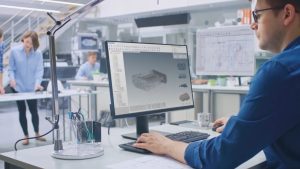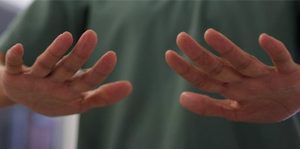It is one of our oldest cultural practices. It’s cited in the scripture of major religions. And it is standard operating procedure in the operating room, or pretty much any hospital or health care facility.
While some now call it part of a “hygiene theatre”, others – like the Canadian government – are investing heavily in it, and in the combined application of artificial intelligence, robotics engineering, surveillance systems and other technologies to improve it.
“It” is washing our hands.
And to make sure we do it well, particularly in the health care setting, but also in commercial, residential, industrial and retail sectors, a new technology platform that uses visual monitoring, image observation and AI data tools to ensure proper hand hygiene is now being rolled out, first at The Ottawa Hospital, one of the largest teaching and research hospitals in Canada.

The AIMS Artificially Intelligent Monitoring System was designed a hospital’s Intensive Care Unit (ICU); it can have uses in other setting as well. Lumenix AIMS image.
The federal government has purchased the Lumenix Artificially Intelligent Monitoring System (AIMS), described by its developers as a state-of-the-art platform utilizing robotics engineering, artificial intelligence and 3-D perceptual systems to help transform hand hygiene monitoring and compliance in health care and other facilities.
While the main physical feature of an AIMS platform looks much like one of those old three-gun video projectors that still hang in the corporate boardroom or school classroom, there is a lot going on ‘under the hood’.
The AIMS system is used to anonymously monitor the activities and positioning of people’s hands in three-dimensional space. It can ‘see’ if hand washing techniques and durations have met operational protocols and sanitary standards. It can ‘determine’ if someone’s washed hands are still sanitized before they come into contact with a patient, and the system can ‘stop’ hand hygiene violations before they happen with real-time notifications.
The system combines advanced sensor technology (similar in some ways to what’s available in advanced gaming consoles with hand gesture and spatial recognition capabilities) and specially trained neural networks (learning from observation, experience and repetition what action meets pre-determined standards) to watch for compliance with – or violation of – hand hygiene policies in a given workspace or physical environment.
AIMS was designed for the often existential demands of a hospital’s Intensive Care Unit (ICU), and along with its observation capabilities, the system provides real-time audible and visible warnings about improper procedures, while supporting compliance rates through analysis of captured data and observed insights that have been otherwise unavailable.

The AIMS dashboard provides insights into compliance rates through the analysis of captured data and observed activities. Lumenix AIMS image.
As it monitors a space, AIMS determines whether someone is washing and sanitizing their hands according to protocol and for the required amount of time. Proper hand hygiene is noted and logged; but if the AIMS system observes a person with unwashed hands, or improperly washed hands, about to contact a patient, it sounds a warning beep and a light on the front flashes as a notification to the observed person to stop and wash their hands.
The technology does not require the observed person to don any wearable hardware, and the company says no identifying video is captured or stored. But of course, people have to heed its recommendations and follow the rules of hand hygiene, sanitary safety and other preventative practices in order to reduce the spread of infectious agents.
The Artificially Intelligent Monitoring System was developed over several years with leading clinicians and engineers at Boston Children’s Hospital. Lumenix acquired a prototype of the system in March 2020 as part of its enterprise move into artificial intelligence and computer vision applications.
Toronto-based Lumenix and its wholly owned subsidiaries have operated business lines in building lighting, controls and automation, sensors, hardware and software. Now it is applying its expertise to cleanliness, and tools to prevent the spread of hospital-acquired infections.
“We are excited about the acquisition of AIMS and our collaboration with Boston Children’s Hospital,” said Scott Delaney, Chairman and CEO, Lumenix. “The AIMS acquisition is representative of Lumenix’s ability to collaborate with world leading institutions, such as BCH, to provide bespoke, game changing, smart technologies for our clients with a focus on efficiency, risk mitigation and safety. For the first time, facilities can monitor every hand hygiene opportunity 24/7 in real time, while at the same time, use AIMS’ proactive communication systems to help everyone in the building feel safer, practice better hand hygiene and reduce the spread of infections.”
According to the World Health Organization and the Public Health Agency of Canada, hand hygiene is the single most effective measure for preventing the spread of infections such as COVID-19 and other hospital-acquired infections.

Hand hygiene is recommended in all national and international infection control guidelines as an effective strategy to prevent health care-associated infections.
(In fact, hand hygiene is a required practice for all health care providers, and recommended in all national and international infection control guidelines as an effective strategy to prevent health care-associated infections (HAI) and limit the transmission of microorganisms, including antibiotic-resistant organisms (ARO). Hand hygiene is one of the five key initiatives set out by the World Alliance for Patient Safety’s Global Patient Safety Challenge.
But amidst the uncertainties, disagreements and discoveries yet to be made about infectious respiratory diseases and our current COVID-19 pandemic counter-measures, many disagree and even disparage what they see as theatrical, ‘over-the-top’ fixations with hand hygiene and surface safety at the expense of counteracting other modes of disease transmission.
It’s a fair argument to heed and from which to learn, but any implication that washing one’s hands is bad is just not good.
Dr. Ignaz Semmelweis made that assertion more than 150 years ago; he’s known as the doctor who discovered the disease-fighting power of washing one’s hands, saving many, many lives in the process. Thousands of years earlier, the cleansing of hands and body was cited in the Talmud, the Quran, the Old Testament and elsewhere as a religious ritual for the faithful as well as a disease-fighter for all.
Despite the sometimes slippery arguments about using soap and water to fight disease, staff at The Ottawa Hospital are enthused about the implementation of new technologies like AIMS.
“We are excited to partner with Lumenix and the Federal Government to bring this world-leading technology into The Ottawa Hospital,” said Dr. Alan Forster, EVP & Chief Innovation and Quality Officer, The Ottawa Hospital. “Effective hand hygiene is an important factor in reducing the spread of infections. Now, more than ever, Canadian health care needs to find ways to keep our facilities safe for patients, staff and visitors.”

A new civic development at The Ottawa Hospital, slated to open in 2028, will be home to some of the most advanced digital technology available so its medical personnel can provide patients with effective new treatments and services. TOH image.
By the way, a new civic development at the hospital, slated to open in 2028, will be a state-of-the-art facility, home to some of the most advanced digital technology available so its medical personnel can provide patients with the most effective treatments and services.
Using clean hands, of course.
-30-



